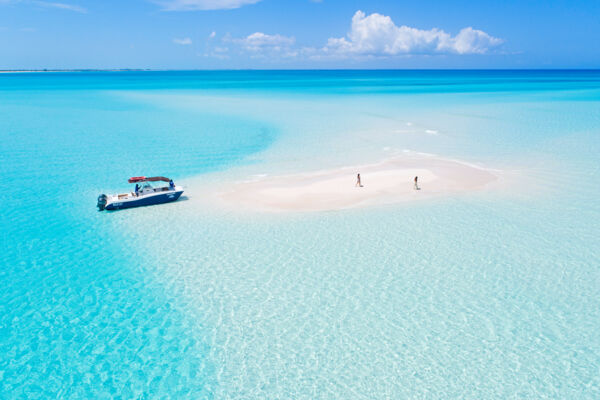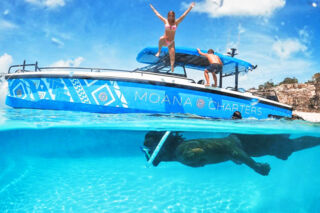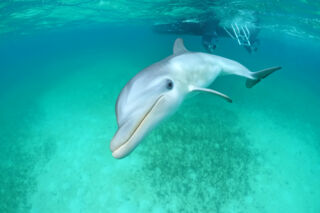Dreamer the Dolphin
Providenciales
After many years exploring the waters of Providenciales on his own, JoJo the Dolphin appears to have expanded his brood. Today, he’s often spotted in the company of what may be his family. To everyone’s surprise, JoJo seems to be the father to a healthy juvenile Atlantic bottlenose dolphin (Tursiops truncatus) affectionately known as Dreamer.
Naturally, Dreamer has garnered a lot of attention due to his playful nature. He is often spotted playing with the sandy bottom, rocks, and shells, enticing snorkelers to play along—and often with his mother, who keeps a watchful eye.
Due to Dreamer’s particularly playful personality, extra care and precaution should be taken by humans fortunate enough to spot him in Turks and Caicos waters.
Where to See Dreamer and JoJo the Dolphin

The best place to spot Dreamer, JoJo, and other resident dolphins in the Turks and Caicos is in the sheltered bay between Grace Bay and Fort George Cay. This includes much of Grace Bay Beach, Leeward Beach, the waters off Little Water Cay, Water Cay, Pine Cay, Sand Dollar Cove, and around Fort George Cay. Dolphins appear to favor the areas off Water Cay and Pine Cay, as well as the deeper sections of Grace Bay and Leeward Beach.
Dreamer the Dolphin and his friends can also commonly be seen in the Caicos Banks near Providenciales. This shallow marine bank is extensive and spans the waters between Provo and South Caicos. The popular La Famille Express shipwreck is a notable attraction in the Caicos Banks, and dolphins can sometimes be spotted in the surrounding waters.
It’s important to follow established guidelines when swimming with dolphins and other marine mammals in the Turks and Caicos. Wildlife is unpredictable and can be dangerous.
- Do not touch or feed the dolphins.
- Avoid splashing your arms or legs excessively.
- Do not chase or harass dolphins, either when swimming or with vessels. They’ll often approach on their own if they’re interested.
- Do not freedive into the dolphin's space.
- Keep your distance from pregnant females to avoid being seen as a threat. It’s common to see baby or juvenile dolphins, and mothers can get territorial.
- Don’t chase, approach, or get between the calf and the other dolphins.
- Do not litter in their environment.
- If a marine mammal charges towards you, get out of the water immediately.
Tour Companies



